A low-carbon fuel facility at Lafarge’s Exshaw plant, west of Calgary, has drawn ire from some residents since it was first proposed and is now operational after years of planning.
Lafarge announced in a press release last week that its new facility is “changing the game in industrial sustainability.”
The facility is set to divert up to 120,000 tonnes of construction demolition waste from landfills annually by burning approved materials including shredded wood, non-recyclable plastics and asphalt roof shingles.
“Our commitment to building a sustainable future is at the core of everything we do,” said Brad Kohl, president and CEO of Lafarge Canada West, in the media release.
“The LCF [low-carbon fuel] project is a prime example of how innovation and collaboration can drive positive change, lowering our environmental footprint through the use of waste biomass materials while closing the material loop to conserve natural resources.”
The company says burned materials would be a mixture of 80 per cent shredded wood and up to 20 per cent shredded plastics, with asphalt roof shingles shredded to three-quarters of an inch.
The materials are delivered by trucks – up to 15 per day – to the Lafarge plant in Exshaw from the company’s recycling centre at the Spyhill Landfill and ECCO Recycling in Calgary. Materials arrive pre-shredded and are burned in a designated kiln to power production, replacing fossil fuels.
The facility is projected to reduce CO2 emissions by as much as 30,000 tonnes annually, according to Lafarge.
While the company says the $38 million facility – backed by $10 million in funding from Emissions Reduction Alberta – will reduce the plant’s reliance on traditional fuels by “replacing up to 50 per cent of natural gas used for one of its kilns,” Exshaw residents have voiced concern since the project was first brought forth to the MD of Bighorn for discussion over 10 years ago.
At a January 2022 Municipal Planning Commission (MPC) meeting where Lafarge applied for the facility’s development permit, some residents reported not feeling heard by the company at a series of open houses, mainly regarding concerns around emissions produced by burning approved materials.
Contaminants of potential concern identified in an overview of a report by Millennium EMS Solutions Ltd., which Lafarge worked with to assess air quality and potential human health risks associated with the new facility include particulate matter, sulphur dioxide [SO2], nitrogen oxide [NO2], metals, volatile organic compounds and poly aromatic hydrocarbons.
An overview of the consultant’s report noted the majority of contaminants were below safe exposure limits. It also noted “a few contaminants of potential concern were greater than exposure limits” but said “these were not considered great enough to pose adverse health effects.”
Lafarge began burning approved materials at its low-carbon fuel facility in September, said the company’s communications and marketing manager for Western Canada, Kristen Marston, in an email.
She noted Alberta Environment and Protected Areas gave approval for the project, and as part of Lafarge’s application process, the company collaborated with various institutes and consultants to study processing the fuels in kilns.
“This included a comprehensive human health risk assessment, which confirmed that there are no health risks associated with the project,” she said.
“Everything for the project is undercover to minimize dust, and there is no odour from co-processing the alternative fuels since there is no organic material besides wood.”
The province’s approval also contains provisions such as requiring monitoring of wind direction and wind speed at the plant, as well as setting limits on the kiln used for burning approval materials’ sulphur dioxide emission rate.
The latest available air quality report on the Lafarge Exshaw website, recorded the week of Sept. 30, shows SO2, NO2 and particulate matter measurements within acceptable levels as set out by World Health Organization guidelines for short-term exposure.
“The conclusion from the human health risk assessment was that there was no potential health risk to burning this fuel,” said Philip Minnaar, a project manager at Lafarge at the time of the MPC meeting.
Some residents suggested a third-party be responsible for monitoring emissions instead of Lafarge.
There were also additional concerns for traffic flow in Exshaw with the number of trucks entering the hamlet increasing.
Lafarge said it would prevent traffic backup on Highway 1A with on-site staging and trucks would be turned away if a backup occurs. A traffic impact assessment Lafarge says it completed in 2022 concluded the project would have minimal impact on the traffic conditions on the highway.
MPC also had concerns over the amount of dust control measures. Part of the agreement required minimizing the dust generated and Lafarge said trucks would be sealed going into a sealed building and then unloaded onto a sealed conveyor.
Lafarge stated in the commission meeting that there should be little dust churned up by trucks, and that they were working to mitigate dust in the air from the processes of the plant itself.
The company notes on its website that it will also explore rail delivery in future years as an alternative to reduce truck traffic associated with delivering fuels.
The Local Journalism Initiative is funded by the Government of Canada. The position covers Îyârhe (Stoney) Nakoda First Nation and Kananaskis Country.



